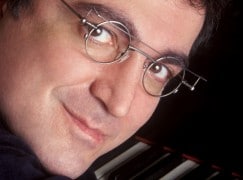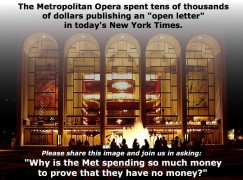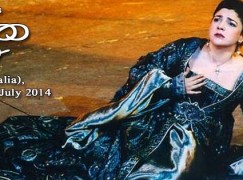This early feminist text is new to us, though actually more than 40 years old. It begins:
You wake up in the morning and find yourself back to back in bed with an unconscious violinist. A famous unconscious violinist. He has been found to have a fatal kidney ailment, and the Society of Music Lovers has canvassed all the available medical records and found that you alone have the right blood type to help.
Full argument here.

He’s guilty of conspiring to hack phones, she’s not.
Her husband and PA also cleared.
Coulson was David Cameron’s media chief. Bad day for chillaxe crowd.
Benedetta Torre is 20 and sounds like the finished article. She’s singing at the Voci Verdiane di Busseto, at the composer’s birthplace.

This is actual security camera footage of a thief coolly planning the theft of a violin in a Utah recital hall.
Watch. Beware. (UPDATE: Outcome here).

**Please share this to everyone who might be helpful to the case**
SLCPD Case Number: 2014-802029
University Police Case Number: 14-1327
Stolen Item: Violin
Missing Date: Monday, June 16, 2014, between 12:00 to 12:25 PM
Owner: Donggin (John) Shin
Email: johnshin.violinist@gmail.com
Summary: As interns for the Summer Chamber Music Workshop, some friends and I were assigned to pick up lunch at nearby Subway (1300 E). The time I left my instrument in the Dumke Recital Hall (4th floor, the University of Utah music building) was at 11:40 AM. According to the surveillance cameras, we were able to see the suspect lurking around outside of the hall from about 11:50 PM. Then later the hall camera spots him putting my violin case (violin inside) into a couple of garbage bags at around 12:17 PM. The thief walks down the main stairs around 12:20 PM, exiting the building (the cams are about 20-25 minutes behind the actual-time).
The Instrument: My violin is made by a Salt Lake City luthier, Scott Brown. The label inside the instrument shows the serial number, “No. 26”, the crafted date, “2011”, and also the luthier, “Scott Brown”. The instrument case is “BAM high-tech contoured case” and the material is carbon fiber.
What’s Unique: From the photos, the violin has 3 oval “washed” varnish marks on the front, bottom part of the violin (1 on the left, 2 on the right). Also it has the golden string “adapter” for the ball-end E-strings (Kaplan ‘no-whistle’ string adapter).
The Suspect: According to the footage… Caucasian male, around 6 feet tall, age between 27-35, some facial hair around chin and mouth, short dark hair (brown-ish). average body build. He also makes some random gestures and speaks with himself throughout the footage. He tends to walk with his feet pointing out about 45 degrees in angle. He were an over-sized grey shirt and jeans (check the suspect photos).
Please let me know if you have any information regarding to the suspect or violin.
Thank you,
John Shin – johnshin.violinist@gmail.com
The somewhat stuttering Swiss mountain festival has secured a major coup this summer – a rare recital by the world’s most sought-after piano teacher, Sergei Babayan.
Based in Cleveland and recently recruited by Juilliard, Babayan has been a magnet for piano hopefuls ever since his outstanding protege Daniel Trifonov won the 2011 Tchaikovsky piano competition in Moscow.
He will play Liszt, Chopin and Bach at Verbier.

Producers Wyck Godfrey and Marty Bowen have cast Ansel Elgort as the young Tchaik-winning pianist in a forthcoming biopic, based on the Howard Reich biography, Van Cliburn.
Elgort is the hot young star of the youth cancer drama, The Fault in our Stars.

close?

The current pay negotiations between the Metropolitan Opera and its musicians are like no previous round.
What in the past was a mud-wrestling bout between professional union officials and opera house management with occasional nods to print media, is now a social media war which the musicians are winning hands down.
Some months ago the musicians set up their own website – not the usual grievance-laden page but a genuinely active and reflective site that gives video insight into their lives, art and work. The site and its blogs have drawn global attention because the content is genuinely interesting.
In addition, the musicians themselves – not local 802 – have set up a rapid response operation to rebut arguments and misinformation going out from Gelb’s office to the mass media. The unit is quick, slick and to the point.
Nothing the Met issues gets past its eagle eye. Every Gelb attempt to seize the public initiative is thwarted by musicians who are more clued up to the mechanics of the modern world. Not unlike events in Iraq, this is an uneven fight which is being won by light-footed combatants against a big, bogged-down machine. Gelb’s Met looks like yesterday’s army.

In a response to today’s wishy-washy editorial, urging both sides to compromise in forthcoming talks, musicians of the Metropolitan Opera Orchestra say the New York Times was quoting salary figures that Peter Gelb had refused to release to them – and which are, therefore, unsubstantiated.
Full statement follows. See also How Met musicians left Gelb for dead.

NEW YORK, NY—Monday, June 23, 2014—The MET Orchestra Musicians and Local 802, American Federation of Musicians, are deeply concerned about the future of the Metropolitan Opera.
Regarding today’s editorial in the New York Times, The MET Orchestra would like to clarify a few important points:
- The Met musicians are paid a competitive contract, a yearly salary that is commensurate with attracting and retaining the best players in the world. The musicians in fact do not have 16 weeks of vacation. Their guaranteed time off is equivalent to that of their peer orchestras (10 weeks), and is in part due to the recognition that they are at the disposal of the Met to perform 6 days a week during the season. Unutilized weeks are due to Peter Gelb’s unpopular and counter-productive decision to end the beloved weeks of free summer concerts in New York City’s parks, which musicians still wish to play (and besides being a wonderful amenity for New Yorkers and visitors are a proven vehicle to expand the opera audience), as well as Gelb’s termination of the practice of touring, which has been a part of the Met season since its inception and also develops tourist audiences for the Met
- Peter Gelb insists on citing an average salary number for musicians that has not been substantiated. The musicians and their legal team have been asking for months for the Met to provide figures showing where they are getting this average salary number, as well as the amount of stated benefits, but the Met has not provided it. We do not know if the Met provided proof to the Times, and we respectfully request that any press covering these matters ask Gelb for documentation to support this disputed figure. Furthermore, we ask that the press consider citing the median salary for the musicians, as this would more accurately represent what most musicians at the Met are paid – if you can get the data from management!
- It is true, as the New York Times states, that The Met cannot continue on its present fiscal course. However, it is relevant to note that over Gelb’s tenure the cost of musician labor has risen only modestly (slightly above inflation), while the non-labor budget increased by 50% ($105 Million). As the musicians pointed out in theirreport to the Met Opera Board the revivals of Peter Gelb’s new productions, which have sold dismally, are pulling revenues down. In fact, when other opera houses around the world are thriving, there has been a 13% drop at the Met box office on Peter Gelb’s watch.
- Given that last year the Met reported a $2.8 Million dollar deficit why does Gelb claim he needs $30 million in cuts (16%) to performers who are already being paid less than musicians in several other U.S. orchestras, in some cases in absolute dollars or, when calculating the cost-of-living to compensation ratio, less than their counterparts at most peer orchestras? Also, importantly, research conducted by the Orchestra indicates that the various cuts that Gelb has proposed actually constitute a reduction in compensation much greater than 16%, but in fact would constitute a 25-37% reduction in compensation.
For a busy international soprano, Tamar Iveri’s diary is surprisingly bare.
Between now and Christmas, all she has listed is a role debut and eight performances as Tosca.
Where?
In Melbourne, with Opera Australia.

Seán Curran, founder of the Seán Curran Company, will become chair of NYU Tisch School of the Arts Department of Dance this fall.

A brief comment we passed some days ago on the appearance of two classical artists’ agents in the Queen’s honour list has provoked an eruption on Classical Music magazine from Andrew Green, a former agent and historian of agents, who feels they are, as a class, upstanding and altogether well-deserving members of society.
The nub of his argument? ‘The concert scene around the world would grind to a halt overnight without the artist manager.’
To which we say, oh, yeah? We’re prepared to bet a Solti souvenir pen to an Abbado signed tie that life would go on just as well without them.
Meanwhile, we happen to live among wonderful people who work day and night saving lives, feeding the hungry, comforting the bereaved, caring for orphans, all without thought of reward or thanks. And a pair of agents waltz away with state honours.

That’s the thesis of Terry Grimley’s new book about the building of Symphony Hall, Birmingham.
The European Commission had told the city that its Regional Development Fund could not be used to build a concert hall. So they called it a convention centre. And Europe turned a blind eye. Details here.













